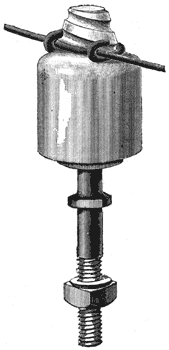[Trade Journal]
Publication: Electrical World
New York, NY, United States
vol. 3, no. 14, p. 111, col. 2
Porcelain Insulators.
BY J. F. KELLY.
I noticed in a recent issue of your admirable publication a few of the results of M. Poussereau's experiments on insulators; and, on reading his figure for porcelain, was reminded of a question which often before occurred to me, i. e.: why are not insulators of this material more generally used in this country? Throughout Europe they are almost exclusively employed, and are found, it is said, to be superior to those of glass. One of those now used in England, known as the Lewis Self-Binding Insulator, would seem to merit more than passing attention. Its construction will be best understood by reference to the accompanying cut in which the insulator is shown with the line wire attached. The upper portion of the outside cup, it will be seen, is of smaller diameter than its main body, and is provided with a conical or expanding screw, the diameter of which increases from the top toward the bottom of the insulator. Instead of the ordinary tie-wire a rigid horse-shoe-shaped metallic clip is used, the inner surface of which is adapted to fit the screw-thread upon the insulator and whose ends are turned over so as to form open hooks adapted to grasp the line-wire. In attaching a line-wire to this insulator, the clip is first fastened to the wire by means of the open hooks at its ends. The conical top is then inserted into the stirrup thus formed and the insulator turned about its cylindrical axis. By reason of the constantly increasing diameter of the screw, the insulator soon comes to a firm bearing, after which it may be placed in its permanent position by mounting it upon a bolt-pin, or bracket, which enters into a suitable socket in the insulator. Among the advantages claimed by the inventor for his mode of attachment are the following: No special tools are necessary either to attach or detach the line. Time is saved because of simplicity and convenience. Any gauge of wire is securely held, whether the line is tightly or loosely stretched. It is impossible for the line-wire to be detached by accident. Every part of the insulator is exposed to the cleansing action of rain, and the clip being galvanized the surface is kept free from rust. The insulator touches the line-wire and clip at three points only, and hence a very small surface is exposed to leakage.
 |
| The Lewis Self-Binding Insulator. |
As now made, these insulators consist of a double inverted cup. The addition of the inner cup, of course, adds materially to the insulating qualities. I think these might be advantageously introduced into this country, if not for general use, at least for particular cases where high insulation is a necessity.
